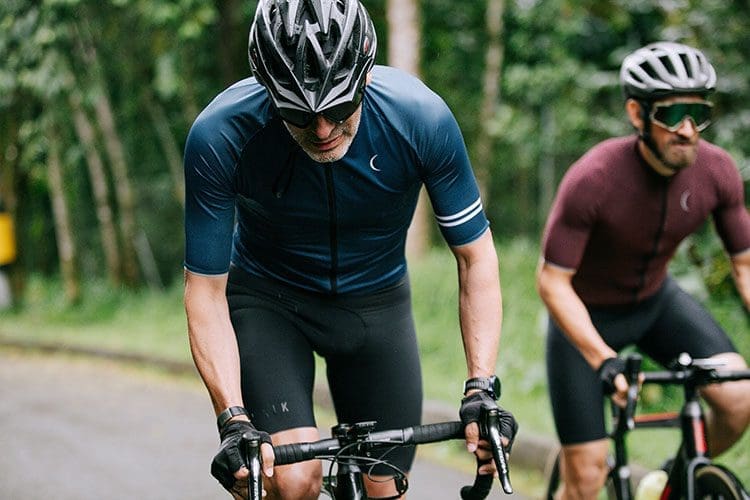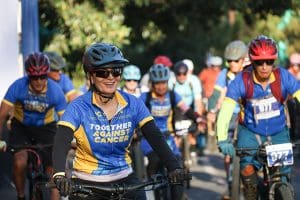I recall being a junior USCF racer in the 1980’s and the variety of ages that would enter UCSF races. One individual, who stood out more from among the others was Barry Wolfe. Barry was an undeniable character who did not meet the typical Southern California cyclist description. He was bulky having spent much of his life as a weightlifter. He wore a “dew rag”, long before the years of Marco Pantani. But most notable was his age. In 1980/1981, the prime years in which I was racing juniors, Barry Wolfe topped the age scales at an ancient 49 years of age. Although Barry had a reputation of burning out competitive cyclists with his daily workout routine, to those of us in the junior field, which on occasion he would join, he was seen as a fragile oddball with whom we should have sympathy, because he had somehow allowed himself to get old. Barry Wolf was 49 years old at that time. I am now 58 years old as I draft this article, a good 9 years older than Barry when we considered him the ancient relic. Who’s the oddball now?
Since the late 1970’s there has been a growing interest in the impact of exercise, cardiovascular exercise in particular, and the process of aging. For some early on in this interest, exercise was seen as a fountain of youth that if done “correctly” prevented the hands of mother nature and father time from robbing one of their youth. As time progressed the research on the impact of cardiovascular exercise has been clear, consistent exercise when completed in moderation offers exceptional health benefits; slows the acceleration of telomere shrinkage thereby slowing the aging process, and assists to maintain endurance, healthy mood, and cognitive performance. But as all of us have most likely witnessed, exercise does not actually stop the aging process.
Psychological Process for Aging Athletes
But what happens when an individual is no longer able to exercise? What psychological process does one experience in response to that loss, and how does one adjust effectively to a new life in which exercise is no longer an option? This article will attempt to address those, and other questions related not only to the relationship of aging and sport participation but to propose a model of how one adjusts to a world without sport.
What is it that motivates an individual to participate in a sport? Sports frequently represent a challenge in which an individual seeks to complete a task while being placed in a compromised situation. Basketball requires one to place a ball in a small opening 10 feet out of reach. Hockey is the attempt to place a small disc in a net using only a stick while your opposition gets in your way. Water polo requires one to throw a ball into a net while treading water. Cycling requires one to go from point A to point B while balanced on two wheels. In the natural world are any of the above skills necessary in helping the ability to navigate day-to-day life responsibilities? Probably not, yet our attraction to participating in those activities might suggest otherwise. When we explore what factors attract one towards sports performance, we can divide those factors into two categories: intrinsic variables and extrinsic variables.
No products found.
Intrinsic Factors
Intrinsic factors relate to personality traits of the individual that initially attract one to a particular sport. Although there are many personality traits that may influence one’s decision to participate in sports, the personality factor that appears to be most identified as providing contribution is that of neuroticism. Neurtotism has classically been viewed as a tendency for one to experience a high degree of anxiety, depression, self-doubt, and other negative feelings in response to conflict. Commonly, individuals rating higher on measures of neuroticism, have also been found to display a higher degree of cortical excitation, and it is theorized that physical exertion or involvement in sports competition assists in the calming and cognitive organizing of that cortical excitation. Individuals with higher rates of the neurotic drive may initially be attracted to perform in sports due to the subsequent calming effects that activity may have on both mood and cognition.
Extrinsic Variables
Extrinsic variables relate to those factors outside one’s personality that either support engagement in an activity or create conflict to reduce interest in that activity. Of those extrinsic factors, the one most commonly identified as having an impact on behavior is that of social affiliation or an identified peer group. Having an identified peer group is commonly associated with increases in one’s sense of belongingness which is then also associated with common themes such as perceived safety, confidence, and competency. Why does social affiliation have such an impact on behavior? It is believed that we are likely drawn to peer groups as historically they have represented protection from natural predators and environmental conditions.
Intrinsic and Extrinsic Variables and their Impact
In summary of both intrinsic and extrinsic variables and their impact on athletic participation, and in regard to the above, whereas the intrinsic factor of neuroticism might be considered the initial prompt to engage in a sport, the extrinsic factor of social affiliation would be considered the factor that continues to provide positive reinforcement of participation in that sport over time. Or, stated differently, one participates in a sport because of the positive effects on mood but continues to participate in that sport over time because it gives one a sense of social identity and perceived safety.
If neurotic drive and a desire for social identity have such a high degree of influence on sport participation, then how is aging affected by those factors? This is initially a difficult question to address as there have been very few comprehensive studies exploring adaptation to sport participation over the life span. What research has been available has in general been limited to exploring the impact of injury and recovery from injury in sport participation, as well as adjustment to forced retirement from sports participation. In the research article the experience of loss in athletes, from the Journal of Sports Medicine (1986), the author S.J. Astle proposed that Elizabeth Kublar-Ross’s five stages of death and dying represented a model of understanding an athlete might experience in response to forced retirement from sports participation due to an injury. To those unfamiliar with Elizabeth Kubler-Ross, she was a Swiss-born individual who worked with individuals in the end stages of life. In her work, she noted familiar psychological patterns in those individuals affected in their final days of life. From her observations, she noted that individuals passed through 5 distinct stages of grief which included denial, anger, bargaining, depression, and acceptance. The first of these stages, denial, tended to be associated with the shock or disbelief one might display in response to being informed of their imminent death. Think “You must have the wrong person. I’m as healthy as a horse” or similar instances in which one might reject negative information provided to them. For the athlete, this might be represented as the athlete who refuses to acknowledge the extent of an injury and continues to play despite decreasing performance results. Anger, the second stage of grief, may be illustrated by the athlete becoming angry at teammates, and envious of competitors, while they themselves experience physical limitations in their sport, either from injury or age-related decline. The bargaining stage, the third of Kubler-Ross’s stages, is illustrated by the athlete who in spite of decreased performance and physical ability, begins to increase the length and intensity of workouts in the hopes that performance may be restored to premorbid levels. The fourth stage, depression, generally marks the point at which the athlete realizes the reality of the situation: the inevitable departure from sport. This period is frequently marked by a loss of interest in the sport, as the athlete’s mood may reflect a general melancholy. Acceptance, the fifth and final stage, marks the point at which the athlete is no longer affected adversely by conversations, reminders, or contact with the sport in which they were once engaged. This period is marked not by a happy acceptance of the loss, but rather by a void of emotion towards the sport; there is neither sadness nor joy, only resolve.
In a further application of Kubler-Ross’s model, in 1982 and 1986, two researchers, Ogilvie and Howe, applied this model to athletic retirement and concluded that the stages of death and dying appeared to be universal reactions among all athletes facing similar situations. Further, they asserted, that the more closely an athlete identified with their particular sport, the more traumatic and hence difficult, the retirement process would be. Within these complex circumstances, an individual may develop frank psychopathology such as major depression and/or generalized anxiety. As applied to the process of declining athletic performance, the athlete may begin to display acting out towards club or team members or may avoid events in which public visibility is likely for events with less known notoriety. When applied to aging, Kubler-Ross’s model continues to appear appropriate for understanding the psychological process by which one adjusts to declines in sports performance and participation.
To add further support of Kubler-Ross’s model, in 1995 I completed a study addressing the process of retirement from competitive sports. To create a model of understanding, I also compared the process of retirement from sports competition to that of experiencing a death of a loved one using Elizabeth Kubler-Ross’s stages of death and dying. Three groups were formulated; professional baseball players who were prevented from playing professional ball due to the national baseball strike (retired athletes), athletes from other sports still actively competing (competing athletes), and individuals who had experienced the death of a loved one (bereaved). As a further explored factor, the motivational drive was also measured using neuroticism as a measured feature for both athletes and the bereaved. To clarify, neuroticism in competition terms was associated with a high competitive drive and did not indicate the common and negative associations that people often attributed to it. Individuals in both the athletic groups and bereavement group were provided with multidimensional measures of grief and measures of personality including neuroticism. It was found that both bereaved individuals and retired athletes rated higher on neuroticism than actively competing athletes, while both bereaved individuals and retired athletes rated higher on measures of grief, while retired athletes with higher rates of neuroticism also rated higher on measures of grief in comparison to retired athletes with lower rates of neuroticism. In other words, anybody who experienced a loss (retired athletes or bereaved) endorsed a higher rate of neuroticism apart from those who had not experienced a loss. If one experienced a loss, they would then display psychological signs of that loss in a manner unique from others who had not experienced a loss. In situations of loss, the more an athlete emotionally identified with a sport the greater the difficulty coping when they were no longer able to participate in that sport.
What does this all appear to suggest? Results from my 1995 dissertation were by and large in support of the use of Kubler-Ross’s model as a means of understanding retirement from sport. Retiring athletes ranked higher on measures of grief than their actively competing peers, and those retired athletes with higher rates of neurotic traits when compared with their peers tended to also display greater difficulty when no longer able to participate in their sport. Taking these findings into consideration with theories regarding the impact of social affiliation, we can begin to understand a clearer picture that the process of aging is not in and of itself a prompt for distress, but merely represents an event that threatens participation in sport and becomes a potential trigger for emotional distress. As we age the possible risk of injury increases and the potential for physical decline increases. Recovery from injury slows, muscles reduce in elasticity, the ability to carry load decreases, and there is a reduction in the efficiency of fast twitch muscle fibers. As we invest our identity with our chosen sport, we initially become part of a larger community, which from a review of the literature, offers us a sense of safety from potential yet unspecific predators. Once injured or experiencing declines in physical ability, that social belongingness becomes threatened triggering many of the responses we might see in an individual who is in the process of grief; denial, anger, bargaining, depression and acceptance. It is not the process of aging itself that prompts distress, but the implications of aging on our ability to function between autonomy and the social affiliation that becomes a dominant concern. This kind of response would be expected in any situation in which an individual displays a high level of personal identity in a role and then is eventually faced with a potential removal from that role thereby threatening the separation of the individual from the social benefits that role provides. As applied to cycling, cycling is a sport that embraces both individual physical prowess and pack mentality. We have to build our strength individually, but when on the road we can funnel that individual strength into social cooperation with other cyclists, thereby increasing speed, protecting us from environmental factors such as wind, and developing a social network that understands the unique features our sport generates. Separation from those benefits, with age being a potential trigger of separation, becomes the predominant existential threat and our body and psyche respond accordingly.
So, as you can see initial attraction to sports participation tends to include certain personality traits, and continued sport participation tends to include social benefits. But what does one do when they are no longer able to participate in their sport due to injury, illness, age, or other possible threats? Are we merely around for the ride, victims to mother nature and father time? Does the process of reduced time in the saddle have to become an existential threat to our sense of identity or safety? Absolutely not. There are many strategies for coping with these inevitable changes and these strategies will be presented in the second part of this series next month.
Eric Yelsa, Ph.D. is a clinical health psychologist in both private practice and within the University of Utah Health Sciences Center. He served as an assistant professor through the University of Utah Hospital Pain Management Center Department of Anesthesiology where he worked with a number of elite and professional athletes recovering from sport-related trauma. He has been a competitive cyclist since 1981. He is a USAC level 3 certified coach and certified power-training coach, has presented at the USA Cycling and is an active member of the American Psychological Association Division 47 Exercise and Sport Psychology. He can be reached for consultation at [email protected]
Photo by Munbaik Cycling Clothing on Unsplash
No products found.











